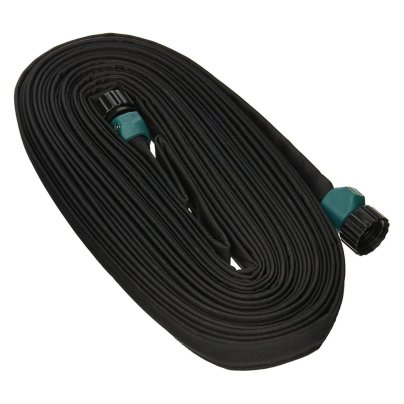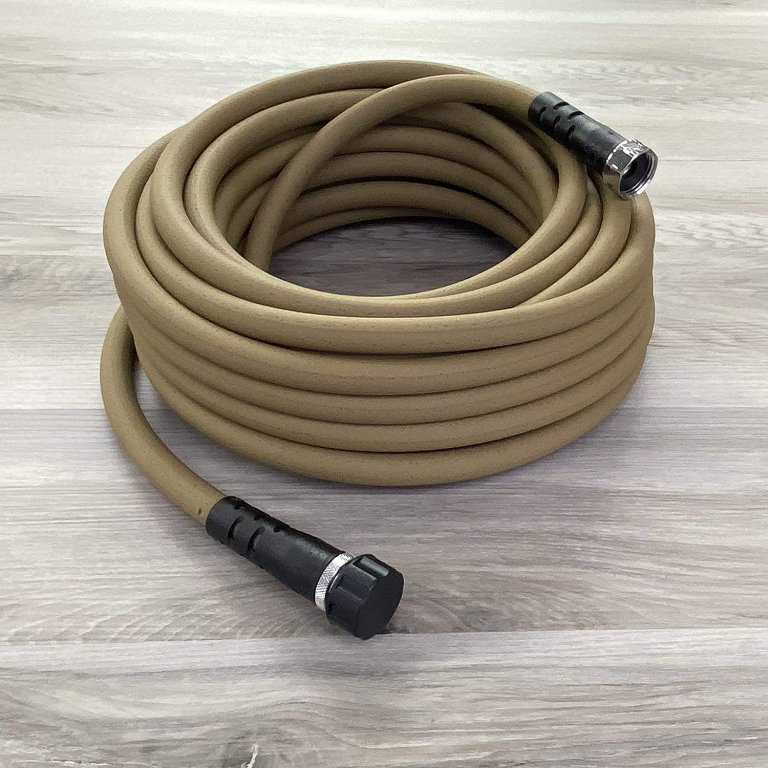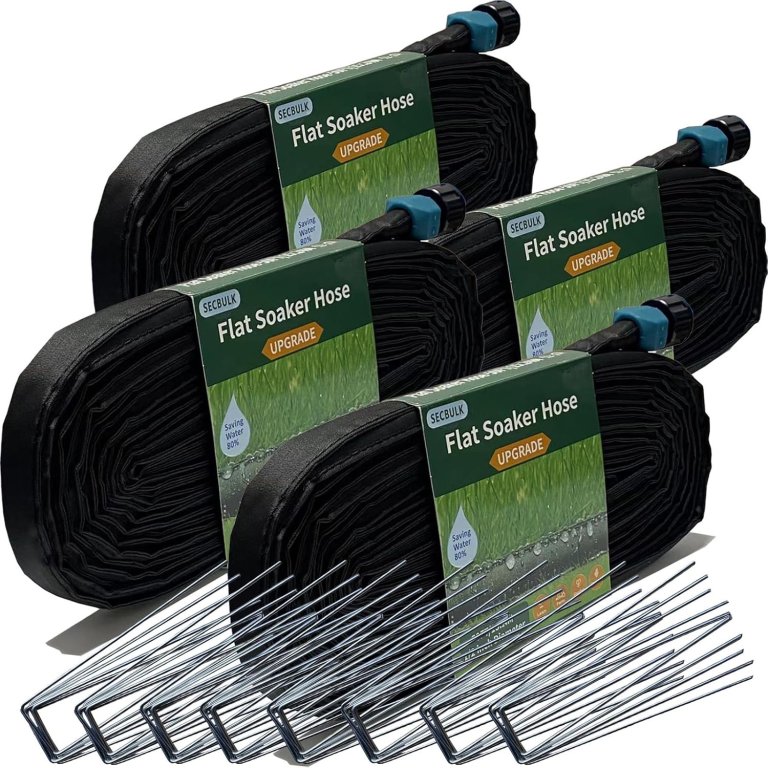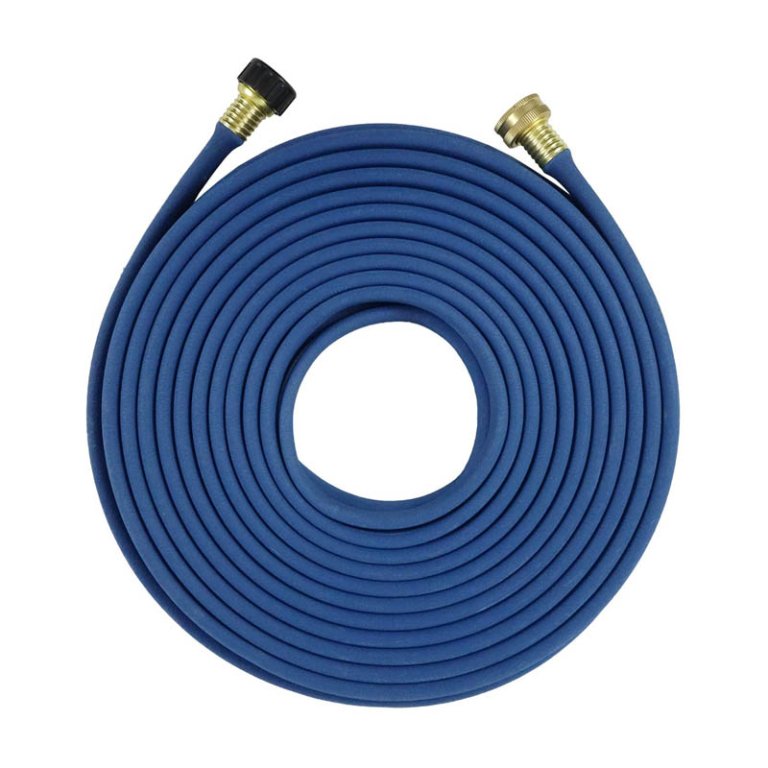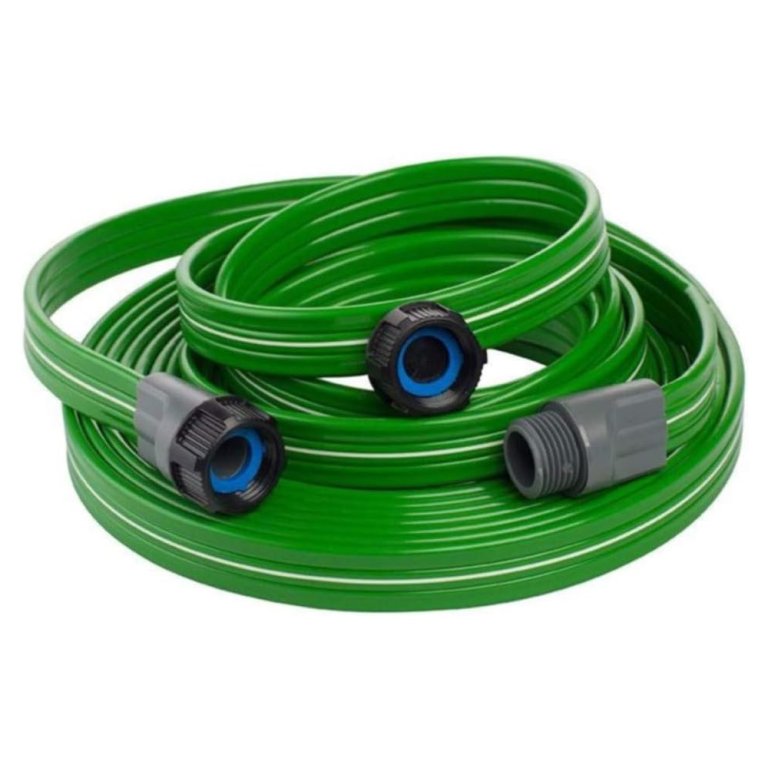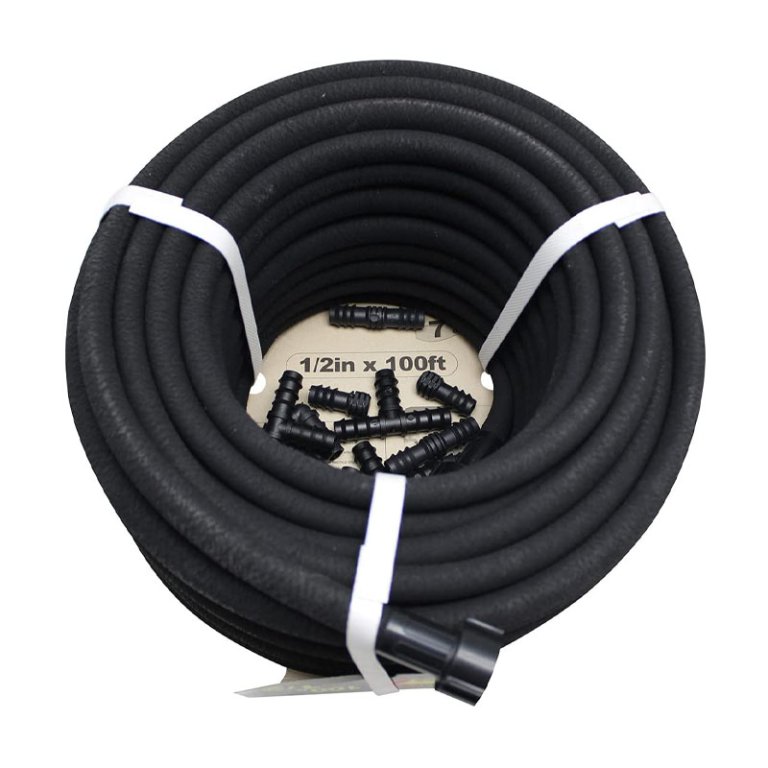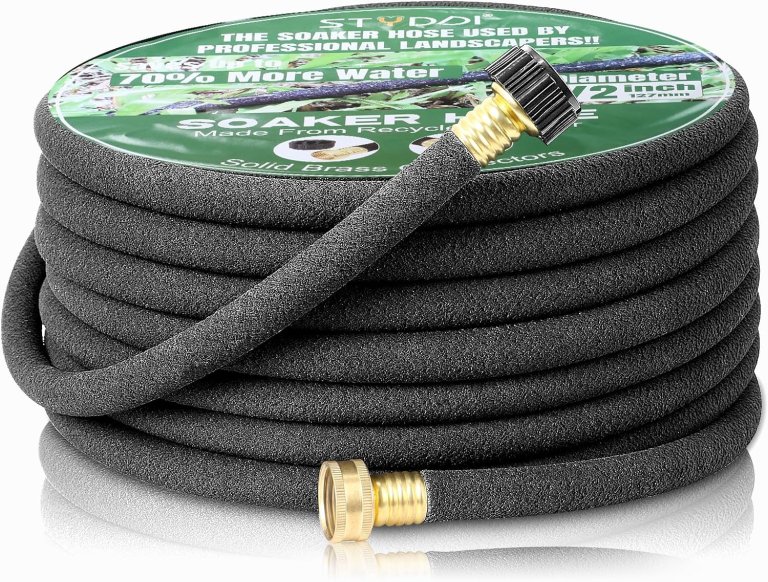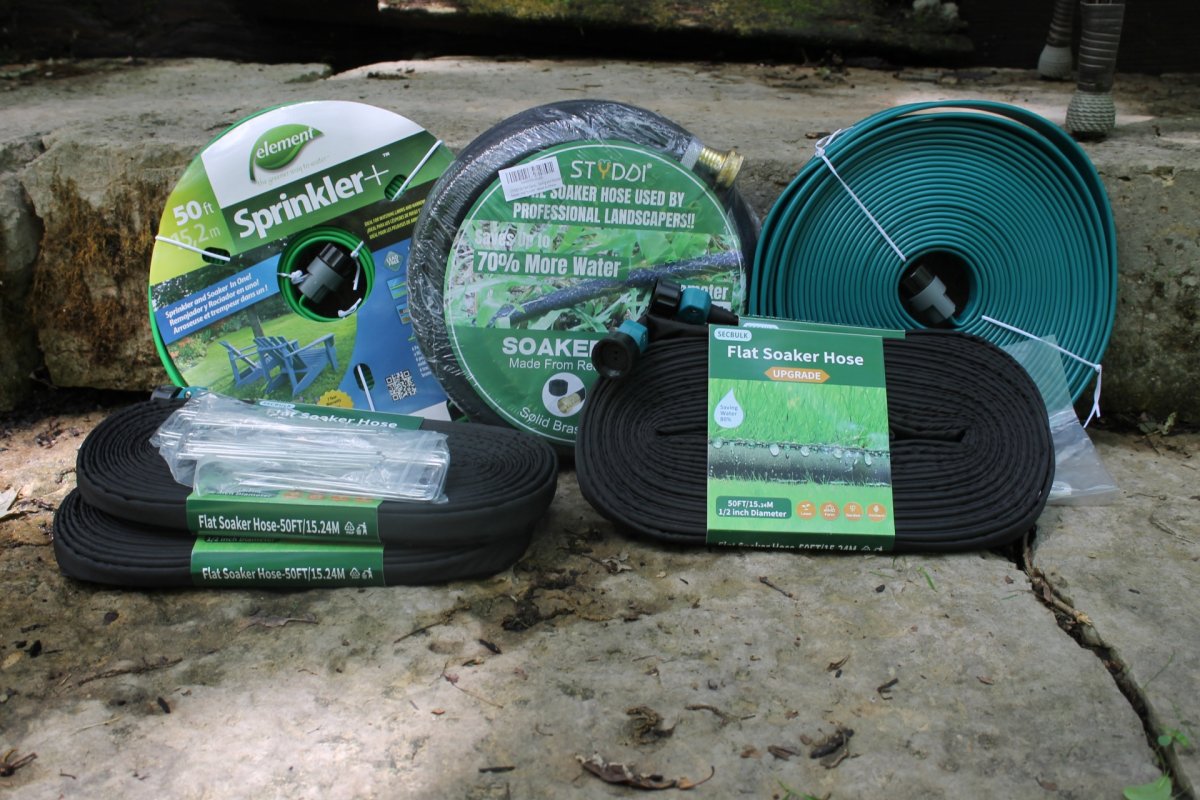
We may earn revenue from the products available on this page and participate in affiliate programs. Learn More ›
When the hot, dry months roll in, a soaker hose can make it a whole lot easier to keep the garden alive and well. These porous hoses provide users with the option to water their plants via a “set it and forget it” system, slowly releasing water directly into the soil toward a plant’s roots. But not all soaker hoses are equal when it comes to gardening or caring for plants, so we put 11 of the top-selling models to the test.
We hooked up the soaker hoses to an outdoor water spigot and observed how evenly they distributed water. We stretched them out, wound them around trees and plants, and carefully inspected each hose’s materials and fittings. Our overall winner was Water Right’s soaker garden hose, which boasts a flexible construction and high-quality fittings.
Ahead, learn how to tell the best soaker hose from a second-rate knockoff, and discover the pros and cons of each model we tested.
- BEST OVERALL: Water Right 700 Series Soaker Garden Hose
↓ Jump to Review - RUNNER-UP: Secbulk 200-Foot Linkable Soaker Hose Kit
↓ Jump to Review - BEST BANG FOR THE BUCK: Gilmour 50-Foot Flat Weeper Soaker Hose
↓ Jump to Review - MOST DURABLE: H2O Works Heavy-Duty Garden Flat Soaker Hose
↓ Jump to Review - MOST VERSATILE: Swan Products Element Sprinkler+ Soaker Hose
↓ Jump to Review - BEST CUSTOM WATERING: Taisia ½-Inch Soaker Hose
↓ Jump to Review - BEST FOR GARDENS: Styddi ½-Inch Soaker Hose
↓ Jump to Review
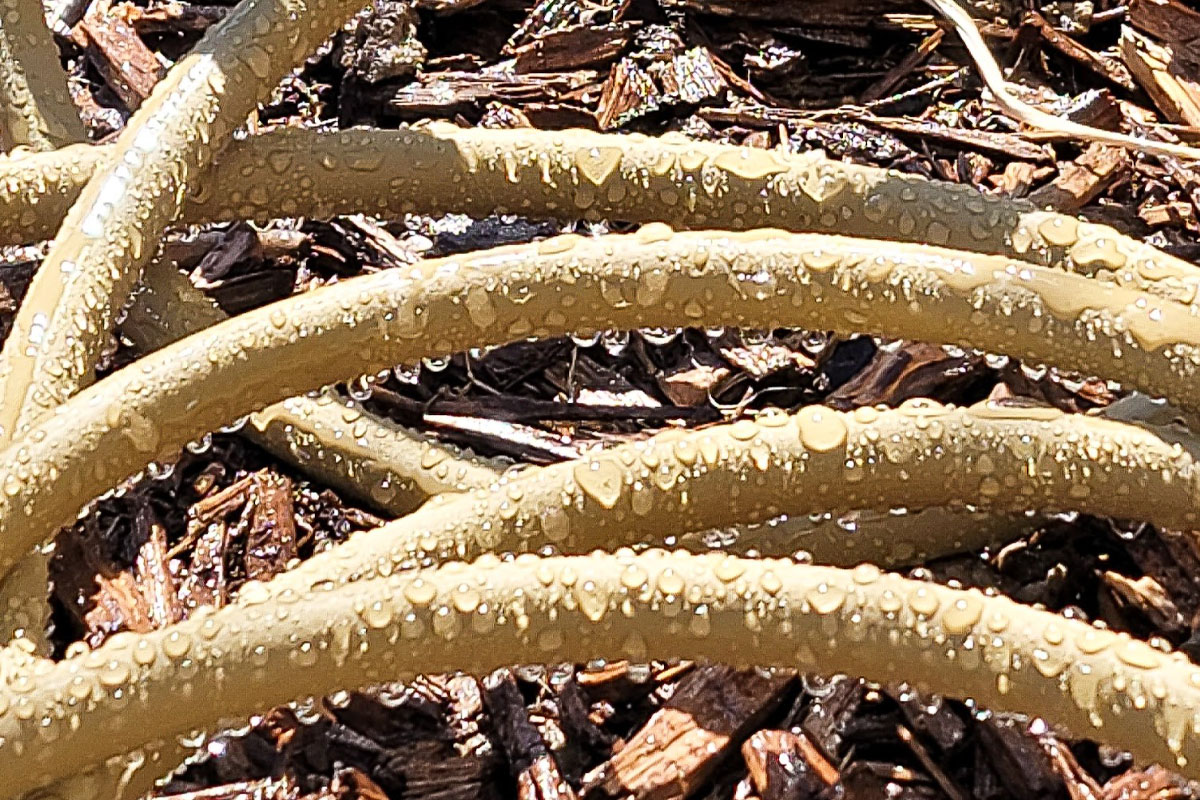
Soaker Hoses Comparison
| Product | Material | Coverage (side to side) | Dimensions |
|---|---|---|---|
| Water Right 700 Series Soaker Garden Hose | Polyurethane, chrome-plated, lead-free brass fittings | About 6 inches on each side after 30 minutes of watering | ½ inch by 25 feet |
| Secbulk 200-Foot Linkable Soaker Hose Kit | Vinyl covered in clog-resistant fabric | About 4 inches after 30 minutes of watering | ½ inch by 200 feet |
| Gilmour 50-Foot Flat Weeper Soaker Hose | Vinyl interior hose, exterior fabric cover, molded plastic fittings | About 8 inches on both sides after 30 minutes of watering | ⅝ inch by 50 feet |
| H2O Works Heavy-Duty Garden Flat Soaker Hose | High-tensile PVC, brass fittings | About 8 inches after 30 minutes of watering | ½ inch by 50 feet |
| Swan Products Element Sprinkler+ Soaker Hose | Plastic | A little over 4 feet after 30 minutes of watering | ¼ inch by 50 feet |
| Taisia ½-Inch Soaker Hose | Recycled rubber, polyethylene, plastic fittings | About 8 inches after 30 minutes of watering | ½ inch by 100 feet |
| Styddi ½-Inch Soaker Hose | Recycled rubber | About 7 inches after 30 minutes of watering | ½ inch by 50 feet |
Our Top Picks
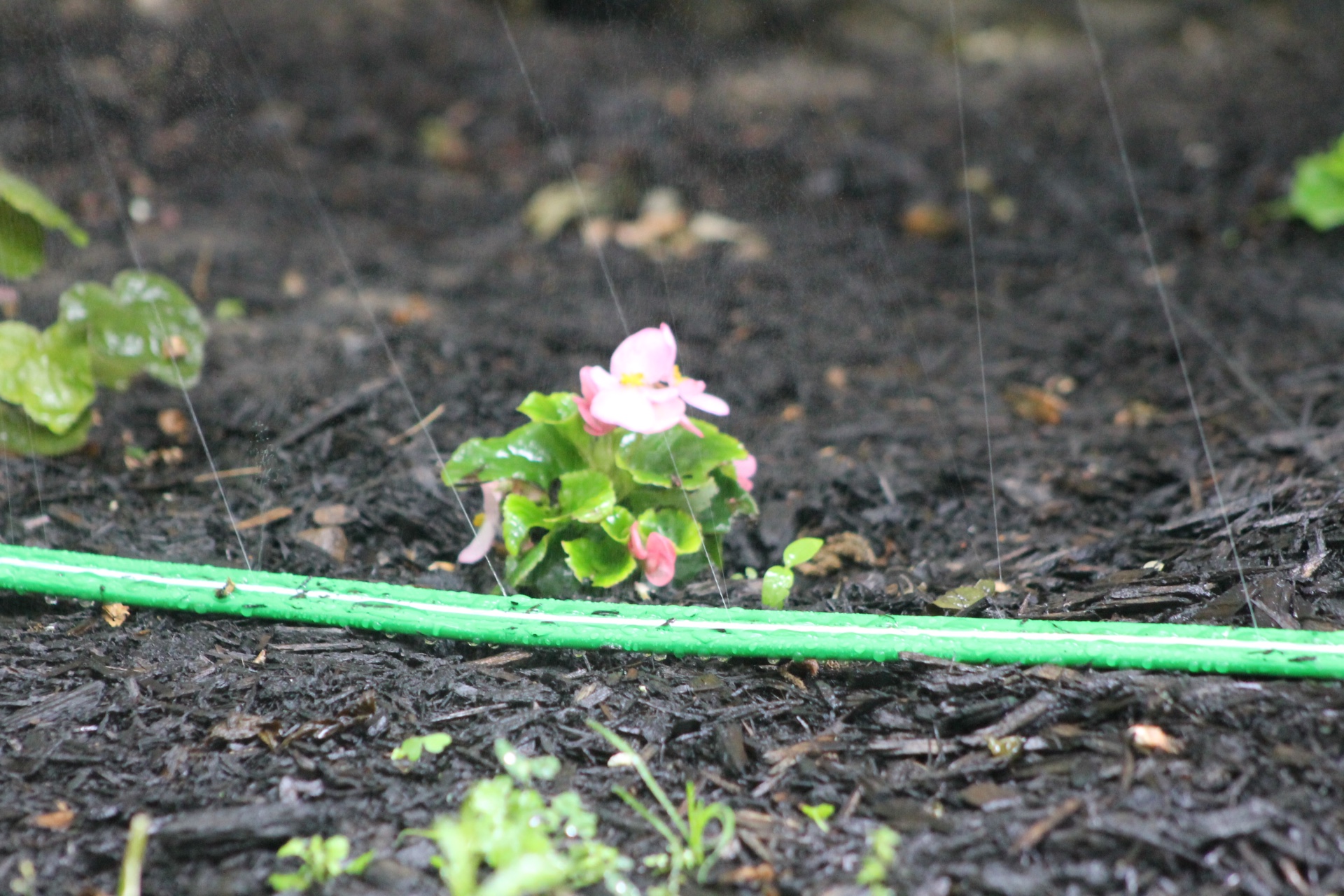
Quality and uniform water dispersion are critical factors in a soaker hose. A quality soaker hose will last all season (or even multiple seasons), while a poor one will be lucky to survive a single summer. We assessed how well each hose distributed water, how easy it was to wind around plants, how much water pressure it could withstand, and the quality of its fittings. The following are the best soaker hoses we tested, each of them suitable for varying needs.
Best Overall
Water Right 700 Series Soaker Garden Hose
What We Like
- Very flexible construction makes it easy to use
- Features a drinking water-safe design
- High-quality fittings that don’t leak with heavy-duty use
- Uniform water distribution system integrated
What We Don’t Like
- Some spraying under high water pressure may occur
Product Specs
- Material: Polyurethane, chrome-plated, lead-free brass fittings
- Coverage (side to side): About 6 inches on each side after 30 minutes of watering
- Dimensions: ½ inch by 25 feet
Our Ratings: Setup 5/5; Maneuverability 5/5; Effectiveness 4.5/5; Durability 5/5; Value 5/5
Unlike other soaker hoses that contain chemicals, the Water Right Soaker Garden Hose is made of FDA-grade polyurethane, and the brass fittings are lead-free. When we first checked out this hose, our first thought was, Wow, how soft! The surface of the Water Right hose feels more like suede than polyurethane. On close examination, we could see the soaker holes were evenly spaced, about ¼ inch apart.
Its smooth, flexible design allowed us to wind it around the bases of shrubs without kinking. We conducted our tests while daytime temperatures were in the 40s, so we expected some brittleness due to cool temperatures, but the Water Right was flexible throughout.
We stretched the Water Right hose out for our coverage test, and after 30 minutes, the moisture from the hose saturated the soil about 6 inches on either side. That was with 20 pounds per square inch (PSI) of water pressure—we used a pressure tester. When we increased the pressure to 40 PSI, we observed some spraying out of the holes. For gardeners who want a bit of misting along with drip-watering, this could be advantageous, but for our purposes, 20 PSI was all that was necessary.
The true intent behind this type of hose (chemical-free) is to supply the cleanest water possible for growing fruits and vegetables. While standard garden hoses do not pose a known risk of contamination, organic gardeners who want to grow the most natural produce possible may find the drinking water quality of the Water Right hose reassuring.
What our tester says: “When I turned the water on, this hose oozed droplets evenly. I checked the entire hose to see if any holes were plugged or gushing water. Nope. Along the entire length of the hose, the water seeped out uniformly.”—Glenda Taylor, Product Reviews tester and writer
Get the Water Right soaker hose on Amazon or Gardeners.com.
Runner-Up
Secbulk 200-Foot Linkable Soaker Hose Kit
What We Like
- Lightweight, pliable, and easy to position
- Installs above ground, under mulch, or under soil
- Interlinkable; can make as long as desired
- Includes garden staples for securing in place
What We Don’t Like
- Has plastic connectors rather than brass
Product Specs
- Material: Vinyl covered in clog-resistant fabric
- Coverage (side to side): About 4 inches after 30 minutes of watering
- Dimensions: ½ inch by 200 feet
Our Ratings: Setup 5/5; Maneuverability 5/5; Effectiveness 5/5; Durability 4.5/5; Value 5/5
The Secbulk 200-foot interlinkable soaker hose includes four 50-foot sections that easily fit together for watering large lawns, gardens, or flowerbeds. Made of clog-resistant fabric wrapped over a vinyl hose, the hose can be installed above ground or buried under up to 3 inches of mulch or soil.
Upon unboxing, we could immediately tell that this hose was of a higher quality than most of the others we had tried. It was soft to the touch, lightweight, and super flexible. While it came with garden staples, setup was so simple and the hose so pliable that we didn’t need them. When we turned our spigot on full pressure, the hose began releasing uniform drops of water, slowly delivering moisture to our plants. After about 30 minutes of running the hose, its area of coverage measured about 4 inches from side to side.
While it only took one 50-foot hose to water the flower bed near our house, we hooked up all four sections to reach a 200-foot length for our garden. This was a simple process, and we didn’t experience any leaking at the connections. For those who don’t need such a long hose but still want high quality, the Secbulk hose is available in smaller lengths, ranging from 10 to 150 feet.
What our tester says: “This is one of my favorite soaker hoses for watering my flower bed and vegetable garden. The hose feels high quality, and I love how easy it is to position around my plants.”—Katie Barton, Product Reviews tester and writer
Get the Secbulk soaker hose at Amazon.
Best Bang for the Buck
Gilmour 50-Foot Flat Weeper Soaker Hose
What We Like
- Lightweight, flexible design can be rolled or compressed
- Durable fittings connect to standard hose outlets
- Water can be drained from hose after use
What We Don’t Like
- Best for lower water pressure (about 20 PSI)
- No storage bag included with purchase
Product Specs
- Material: Vinyl interior hose, exterior fabric cover, molded plastic fittings
- Coverage (side to side): About 8 inches on both sides after 30 minutes of watering
- Dimensions: ⅝ inch by 50 feet
Our Ratings: Setup 5/5; Maneuverability 5/5; Effectiveness 4/5; Durability 4/5; Value 4/5
This flat weeper soaker hose from Gilmour arrived in a small package weighing less than 1.5 pounds, and we had our doubts that it would be worthwhile for watering. We were wrong. The Gilmour hose features a thin, flexible vinyl hose encased in a tightly woven fabric sleeve that keeps the interior vinyl from expanding too much, making it the perfect soaker hose for lawn watering.
We stretched the Gilmour garden soaker hose out to its maximum length of 50 feet and connected it to the outdoor spigot. We turned on the water pressure to 20 PSI and observed the watering pattern. The hose became round under pressure, and water came out in a mostly uniform fashion, although some hose areas seemed to emit slightly more water than others. We then wound the hose around the bases of trees and shrubs and turned the water on for 30 minutes.
After our test watering was complete, we inspected the ground’s dampness around this Gilmour soaker hose. The water had saturated a swath about 8 inches wide on both sides of the hose. We then drained the water from this small soaker hose, and we were able to roll it around an old cardboard paper towel core, reducing its size to less than a foot in diameter.
The Gilmour hose is budget-friendly and well suited to directing water to the bases of plants, but we felt it was slightly on the delicate side. It worked well with low water pressure, but we would not recommend using it with higher water pressure (over 25 PSI).
Get the Gilmour Weeping soaker hose at Amazon, Ace Hardware (25 feet), Walmart, or Target.
Most Durable
H2O Works Heavy-Duty Garden Flat Soaker Hose
What We Like
- High-quality, flexible PVC construction
- No-leak brass fittings for user-friendlines
- Uniform water distribution system integrated
- Will withstand higher water pressure situations if necessary
What We Don’t Like
- Blue color stands out unless covered with mulch
Product Specs
- Material: High-tensile PVC, brass fittings
- Coverage (side to side): About 8 inches after 30 minutes of watering
- Dimensions: ½ inch by 50 feet
Our Ratings: Setup 4/5; Maneuverability 5/5; Effectiveness 4.5/5; Durability 5/5; Value 4.5/5
Two things stood out immediately upon unboxing the H2O Works Soaker Hose: its bright blue color and the fact that, although this is a flat hose, it’s made from flexible, high-tensile PVC rather than thin vinyl covered with fabric. When we turned on the water pressure, the H2O Works became a round soaker hose with weep holes on all sides, and it was a simple process to wind it around bushes and plants without the hose kinking.
The H2O hose distributed water evenly along its 50-foot length with just 20 PSI of water pressure. Since it’s made to withstand higher pressure, we turned the spigot all the way up, which was about 55 PSI. Water output increased, and we noted a bit of spraying, but other than that, the hose held firm. When it was time to store the hose, it flattened once again for easy rolling, and we were able to wind it up around our hose reel without kinking.
The H2O comes infused with UV protectors to resist damage from harsh sun rays, and it features durable brass end couplings that showed no signs of leaking, even under high pressure. The blue color is eye-catching, but we found it to be a little too colorful for our tastes. It definitely stands out wherever it is placed, so unless gardeners want a bright blue stripe in their landscaping, it will have to be covered with mulch.
Get the H2O Works soaker hose at Amazon or The Home Depot.
Most Versatile
Swan Products Element Sprinkler+ Soaker Hose
What We Like
- Works as a sprinkler or soaker hose
- Lead-free and drinking water-safe
- Flexible, lightweight, and easy to position
- Budget-friendly price point
What We Don’t Like
- Has plastic fittings
Product Specs
- Material: Plastic
- Coverage (side to side): A little over 4 feet after 30 minutes of watering
- Dimensions: ¼ inch by 50 feet
Our Ratings: Setup 5/5; Maneuverability 5/5; Effectiveness 4.5/5; Durability 4/5; Value 5/5
Those looking for an affordably priced hose that can do it all should look no further than the Swan Element Sprinkler+. It features a flexible design that’s easy to position and has six holes for every foot of hose. One side of the hose has a white stripe, and the other side is solid green. When the white strip is positioned upright, the hose acts as a sprinkler; when it’s positioned facing down, it works as a soaker hose.
We tested this hose in both positions (as a soaker and a sprinkler). While the soaker did a good job of dripping water to our plants’ roots, we also appreciated the wide spray pattern the sprinkler hose provided. We let it run for 30 minutes and then measured how far the spray reached, which turned out to be over 4 feet. While we tested this in a flower bed near our house, we plan on using it between garden rows to water our vegetable plants on hot, sunny days.
After use, we drained this flat sprinkler hose by unscrewing the male end fitting and allowing any stored water to run out. Since the hose is lightweight and flexible, it was easy to wind back up for storage. There’s not much we don’t like about this hose. If we were to nitpick, our only complaint would be that it has plastic connectors rather than brass fittings.
Get the Swan Products soaker hose at Amazon.
Best Custom Watering
Taisia ½-Inch Soaker Hose
What We Like
- Uniform water distribution system for ease of use
- Withstood up to 40 psi for heavy-duty use
- Suitable for watering and washing vehicles
- Customizable with included fittings
What We Don’t Like
- Slightly stiff at cool temps
- Tendency to kink at cool temps
Product Specs
- Material: Recycled rubber, polyethylene, plastic fittings
- Coverage (side to side): about 8 inches after 30 minutes of watering
- Dimensions: ½ inch by 100 feet
Our Ratings: Setup 5/5; Maneuverability 3.5/5; Effectiveness 4/5; Durability 5/5; Value 4/5
In our tests, we found that this soaker hose system from Taisia maintained equal pressure from end to end, a sometimes-challenging accomplishment for longer-length soaker hoses. We started testing the Taisia hose at 20 PSI and found that it was sufficient for even water distribution. Then, we turned up the pressure to 40 PSI and noted that the droplets came out faster, but we didn’t observe any spraying or leaks. The distribution was still even and uniform.
The hose was relatively easy to wind around the bases of trees and shrubs, but it was slightly stiff to begin with. Keep in mind that the outdoor temperature was in the 40s when we tested this hose, which kept it from being as flexible as it would be on an 85-degree summer day. As the sun shone on the hose, it warmed up slightly and was more flexible.
The hose did develop a couple of kinks we had to work out. This, too, would likely be less of an issue in warmer weather when the hose was more flexible. An added feature of the Taisia hose is the ability to adapt it to a custom watering configuration. This is possible via a set of plastic soaker hose connectors, T-fittings, and end caps (all included), all of which allowed us to cut sections of the hose and fit them together to form watering “branches.” We didn’t have any problem with leaking fittings, which was a big plus.
Get the Taisia 1/2-Inch soaker hose at Amazon.
Best for Gardens
Styddi ½-Inch Soaker Hose
What We Like
- Made of durable rubber with brass connectors
- Provides an even distribution of water
- Removable end cap makes it extendable
- Built-in gasket filters out debris
What We Don’t Like
- Not very flexible; hard to initially position
Product Specs
- Material: Recycled rubber
- Coverage (side to side): About 7 inches after 30 minutes of watering watering
- Dimensions: ½ inch by 50 feet
Our Ratings: Setup 4/5; Maneuverability 3/5; Effectiveness 5/5; Durability 4.5/5; Value 5/5
The Styddi soaker hose is constructed of recycled rubber and features high-quality brass fittings that connect to any standard ¾-inch hose or outdoor faucet. Out of the box, it felt much more rigid than we had anticipated, but also durable. The manufacturer recommends leaving the hose out in the sun for an hour to help soften it before setup. Even after doing this, the hose still felt somewhat stiff, so we carefully arranged it around the plants in our flower bed and used garden staples to secure it in place. This worked well, and the setup only took a few minutes.
When we turned our spigot on, we were impressed by how much water seeped out of this soaker hose. The water distribution was even and plentiful, spread about 6 inches wide side to side after running the hose for 30 minutes. Even when we turned our water down to half pressure, there was still plenty of water for plants to soak up.
After use, we wound up the hose. We found winding it up to be pretty straightforward, but we did notice that the hose was susceptible to bending and kinking if not wound properly. While this wasn’t a major issue for us, it’s something to be aware of. Overall, we found that this drip system soaker hose was a great value for the price, and aside from being a little stiff, it worked as it should.
Get the Styddi soaker hose at Amazon.
Jump to Our Top Picks
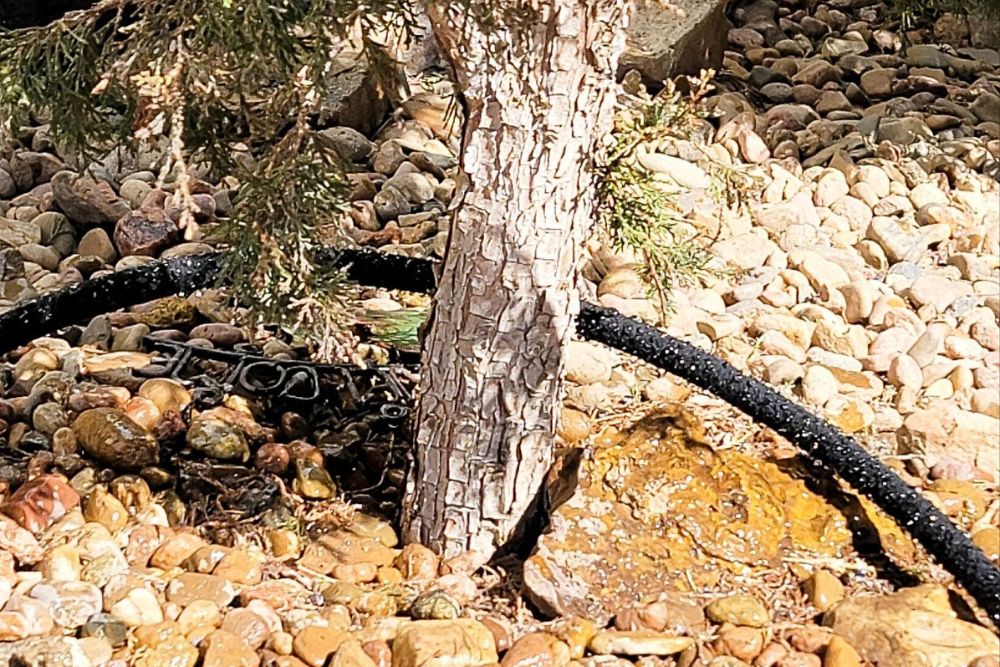
How We Tested the Best Soaker Hoses
| Testing Stats | |
| Products tested | 11 |
| Time spent testing | 10.5 hours |
| Tests performed | 6 |
| Price range | $20 to $100 |
While soaker hoses are straightforward garden products, they tend to receive mixed reviews, often because they can’t accommodate high water pressure the way standard hoses can. Having used soaker hoses in the past, we understood that the perforations in soaker hoses create weak spots in the hose that can rupture under too much pressure. So, we started testing each soaker hose at just 20 PSI of water pressure, using a pressure tester to ensure accuracy. If the hose performed well at that pressure, we increased it to 40 PSI. (A standard outdoor spigot typically runs at somewhere between 35 and 55 PSI.)
We inspected both the hoses and their connections for leaks, and awarded points based on how evenly the water was distributed throughout the hose. However, we didn’t stop after our first round of testing. As new products hit the market, we tested them using the same metrics described above and rated them according to our standardized rubric. We then tallied the points and used them to determine which hoses would earn a spot in our lineup.
Some of the hoses came with the ability to create custom watering configurations, while others were available in only one length. We initially selected hoses based on factors such as manufacturer reputation. However, we didn’t automatically eliminate hoses from newer, smaller, or niche manufacturers as long as they were made from quality materials and performed well.
| Product | Setup | Maneuverability | Effectiveness | Durability | Value |
| Water Right 700 Series Soaker Garden Hose | 5/5 | 5/5 | 4.5/5 | 5/5 | 5/5 |
| Secbulk 200-Foot Linkable Soaker Hose Kit | 5/5 | 5/5 | 5/5 | 4.5/5 | 5/5 |
| Gilmour 50-Foot Flat Weeper Soaker Hose | 5/5 | 5/5 | 4/5 | 4/5 | 4/5 |
| H2O Works Heavy-Duty Garden Flat Soaker Hose | 4/5 | 5/5 | 4.5/5 | 5/5 | 4.5/5 |
| Swan Products Element Sprinkler+ Soaker Hose | 5/5 | 5/5 | 4.5/5 | 4/5 | 5/5 |
| Taisia ½-Inch Soaker Hose | 5/5 | 3.5/5 | 4/5 | 5/5 | 4/5 |
| Styddi ½-Inch Soaker Hose | 4/5 | 3/5 | 5/5 | 4.5/5 | 5/5 |
What to Consider When Choosing a Soaker Hose
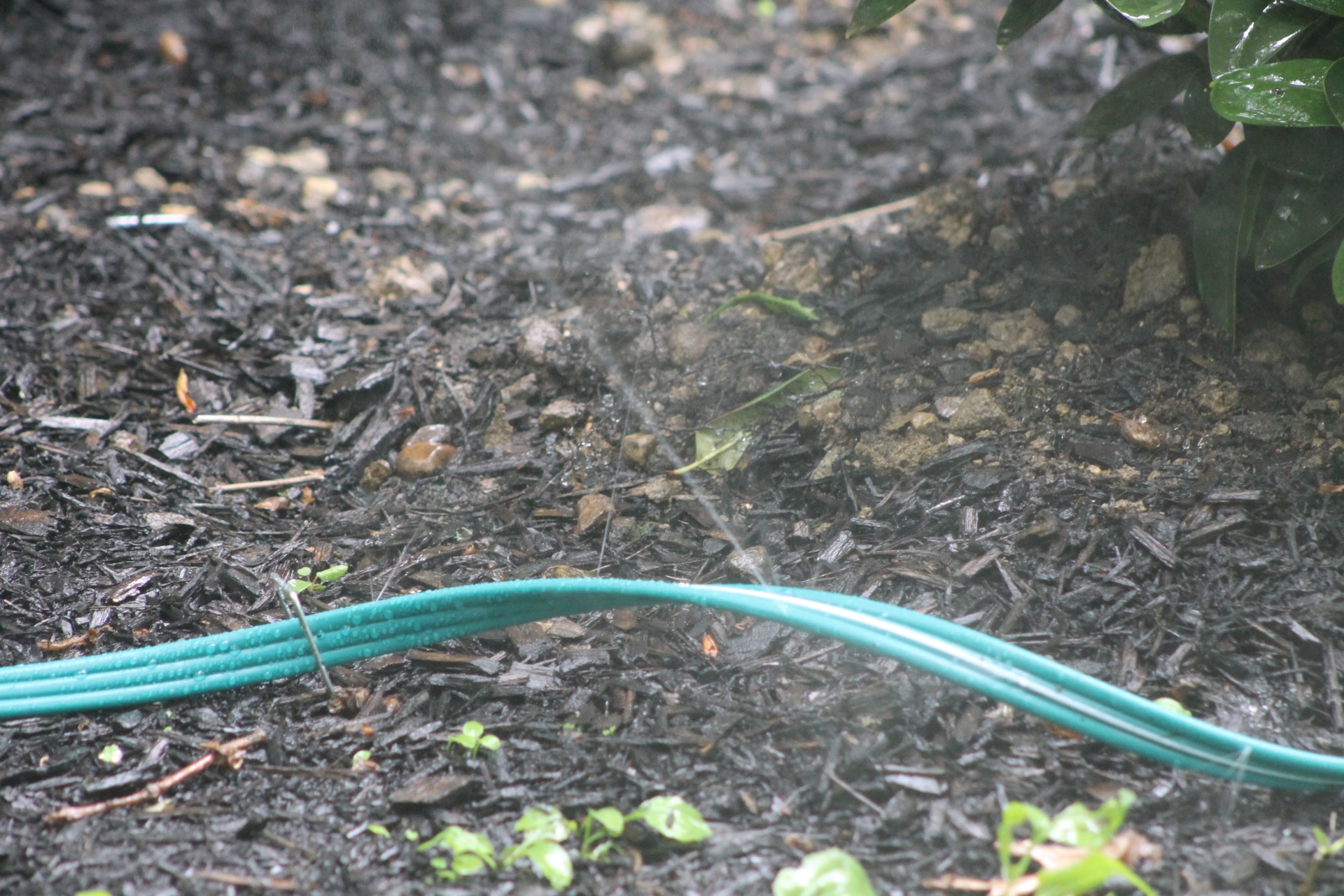
Traditional sprinklers spray water into the air, much of which can evaporate on a hot day before it even reaches the ground. Using a conventional garden hose with an attached hose nozzle can help cut down on water waste, but it’s not a perfect solution. Enter the soaker hose, which is a type of watering hose with holes that release moisture into the ground rather than on a plant’s leaves. With a soaker hose, water soaks directly into the root zone (hence the name), allowing plants to absorb water slowly. Because soaker hoses don’t spray plant foliage (or shouldn’t), they can reduce the risk of plants developing the fungal problems commonly associated with saturated foliage.
We tested the top soaker hoses for gardens for flexibility, quality, and water distribution, as these are the features that home gardeners are typically most concerned with. We also analyzed each hose’s ability to withstand common outdoor spigot water pressures.
The best soaker hose for an individual gardener will vary depending on budget, dimensions, and whether it will be buried or positioned on top of the soil. Before ordering a soaker hose, consider what materials it’s comprised of and whether it’s the right size and type for the intended space.
Material
Designed to allow water to seep through tiny perforations directly into the soil around the plants, soaker hoses are made of recycled rubber, polyurethane, and flexible polyvinyl chloride (PVC). High-end soaker hoses may also contain fiber reinforcement, making them durable and suitable for years of use and able to withstand intense water pressure. Less expensive models may feature thin vinyl and typically last just a single season, or two at the most, but these will require replacement when the vinyl becomes brittle or develops cracks.
Size and Weight
Soaker hoses come in a range of sizes, from short 15-foot lengths (which are optimal for small flower beds) to lengths of 100 feet or even longer, making them suitable for large perennial borders or long rows of summer vegetables. The diameter of the hose can also vary, from ⅜ inch up to 1 inch. Larger-diameter hoses often feature more perforations or weep holes, allowing them to deliver large amounts of water quickly. Larger hoses require more water pressure than narrow soaker hoses. (See the “Pressure Rating” section below.)
The larger the hose, the heavier it will be. A hose’s weight depends on the material the hose is made from. In general, a heavier rubber hose is more likely to stay in place, whereas a lightweight hose may arc or move under the water’s pressure. Burying any soaker hose for watering plants under 1 to 2 inches of mulch will help keep it in place, and the mulch will also help keep moisture in the soil from evaporating.
Flat vs. Round
When choosing between a flat and a round soaker hose, keep the following in mind.
- Flat hose: For many gardeners, flat soaker hoses are just the ticket for watering long, straight rows of summer-grown vegetables. Even so, a flat irrigation system soaker hose has its drawbacks. Rather than weep holes located on all sides of the hose, the holes are typically (although not always) on only one side of the hose. Winding a flat hose for storage can result in kinks, which can restrict water flow. Flat soaker hoses are available in various materials, including vinyl, rubber, PVC, and polyurethane. They’re best suited to laying out along straight garden rows rather than snaking around the bases of plants, trees, and bushes.
- Round hose: A round soaker hose is more versatile because it can be used on straight rows and snaked around various bushes and trees, usually without kinking. Round soaker hoses tend to be more flexible and durable, and while they may be initially more expensive, they often last longer than flat vinyl hoses, so they may pay for themselves in the long run. Both types of hoses can be buried under 1 to 2 inches of mulch.
Coverage Area
Expect a typical soaker hose to saturate an average of 6 to 12 inches on either side of the hose. Coverage will also depend, however, on the duration of the watering cycle. A watering cycle of 1 hour will result in a broader spread of moisture than a cycle of just 30 minutes.
Pressure Rating
Many soaker hoses don’t come with pressure ratings, but water pressure, measured in pounds per square inch (PSI), is still worth considering. The longer and broader the soaker hose, the more water pressure it’ll need to evenly distribute water to the holes at the end of the hose, so it may require the user’s outdoor spigot to produce water up to 50 PSI—but that’s relatively rare. On the flip side, a short, thin vinyl hose might not withstand that much water pressure; it might be better suited to just 20 PSI of pressure. In general, soaker hoses made from polyurethane, PVC, and rubber will withstand higher pressure than those made from vinyl.
Rather than worrying about the water pressure at the spigot, which, in most cases, is adequate to run a soaker hose, experiment a bit when first using the hose. After laying out a soaker hose and before covering it with mulch, turn on the water—just a bit—and see if it’s enough for water to seep out of the holes at the far end of the hose. If it isn’t, gradually increase the water pressure at the spigot until water comes out of the holes. Once it does, make a mental note of how far the faucet was turned and use similar pressure each time.
Most soaker hoses require relatively low pressure—around or less than 20 PSI—to produce even water distribution. Once the hose is pressurized, it will remain filled with minimal additional water pressure.
Backflow
While relatively rare, anytime a spigot is in the “on” position and a hose (or more likely an underground sprinkler system) is pressurized, there’s a chance the water will backflow from the pressured hose or sprinkler system into the spigot. This can only occur when the spigot is turned on. When it’s in the “off” position, no water can flow in or out.
The water inside a soaker hose is not considered “potable,” meaning it could be contaminated from soil or fertilizers that entered the hose through its weep holes, making it unsuitable for drinking. To prevent backflow contamination, users can install a backflow preventer between the spigot and the hose, which will prevent water in the hose from entering the home’s water supply system. Backflow preventers are simple, inexpensive attachments that usually run less than $10 and are well worth the peace of mind they offer the user.
The Advantages of Owning a Soaker Hose
Directing water to a plant’s roots rather than broadcasting it indiscriminately over the foliage concentrates the water where it’s needed most. It also offers some other benefits.
- Using a soaker hose is a one-and-done operation. All you have to do is turn on the water at the spigot for 30 minutes or so—no need to hand-water plants with a typical watering wand.
- Soaker hoses conserve water, so your utility bills may be lower.
- Since soaker hoses don’t deposit water on the foliage, the risk of fungal diseases is reduced.
We interviewed Peggy Anne Montgomery, a horticulturist at the Garden Media Group, who shared her expert gardening knowledge. “I think soaker hoses are great for vegetable gardens where the hose can be laid out in the pattern of the rows. The water is delivered gently and will not overwhelm small plants.” In terms of water efficiency, she added that, “since it drips directly into the soil, it is a very efficient use of water because very little, if any, evaporates.”
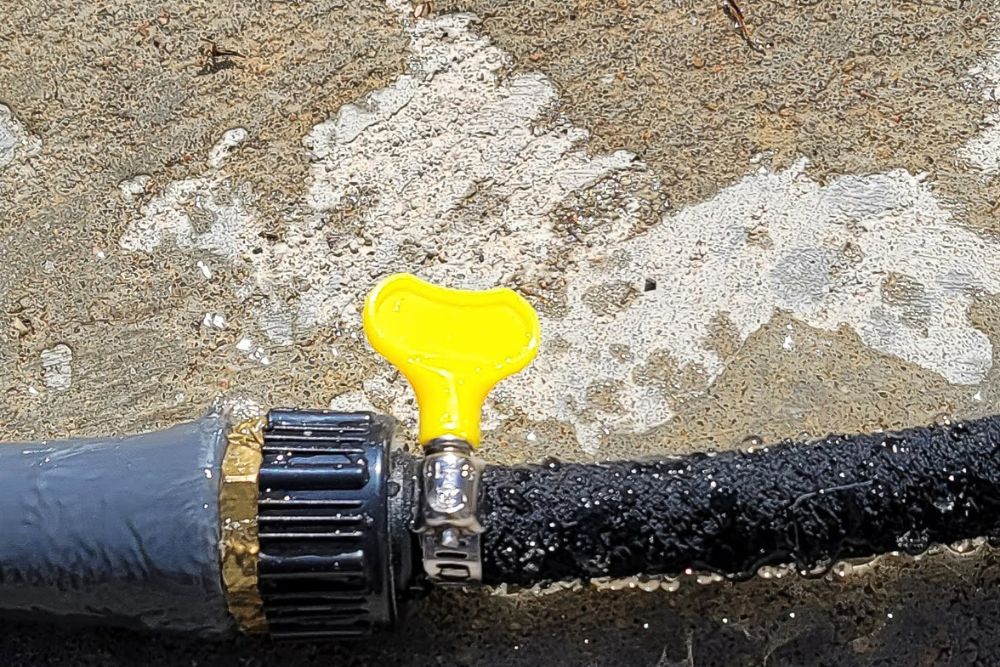
FAQs
Conserving water, reducing garden and landscape maintenance time, and improving plant quality are all excellent reasons for wanting to use a soaker hose. New gardeners might also wonder how to use a soaker hose or have questions like “What is a soaker hose, exactly, and how does it differ from other watering methods?” Read below for answers.
According to Montgomery, “soaker hoses only seem to last about 2-3 years.” However, you may be able to prolong this, she says, by “covering them with 1-3 inches of mulch to protect them from sun damage”.
A soaker hose features weep holes along its entire length, while a drip hose features a solid tube with attached drip emitters that can be custom installed to direct water to the base of individual bushes or plants.
Water usage can vary, depending on the soaker hose’s length and type, but in general, a 50-foot hose will distribute approximately 30 gallons of water in 1 hour.
In typical growing situations, running a soaker hose twice weekly for about 30 minutes each time may be sufficient. Water less frequently during a rainy or cool season, and water more often during a drought. Also, consider adding mulch around plants’ bases to keep moisture in the soil from evaporating quickly.
Twice a week for about 30 minutes each time. It’s usually better to water deeply less often than to water just a bit more frequently.
As long as the outdoor spigot has sufficient pressure to deliver water to the end holes on the farthest hose, feel free to connect two or more soaker hoses end to end.
Meet the Tester
Glenda Taylor is a product tester and writer specializing in the construction, remodeling, and real estate industries. She and her husband own a general contracting company, and Taylor is experienced in both residential and commercial building applications. She tests a wide range of power tools as well as other home improvement, household, and lawn-and-garden products.


